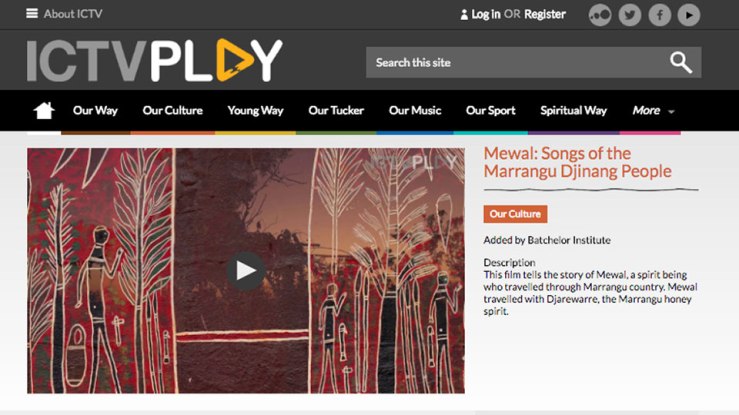In my previous post I aimed to explain the role television media has in Australia in constructing the cultural understanding of individuals and also political understanding through news and current affairs. There is therefore a relationship between a lack of media representation in television and inequality for Indigenous Australians. In this half of my case study I will explore the role Imparja Television has had in addressing the issue of access as Australias first Indigenous controlled commercial television station broadcasting to remote and sparsely populated regions of Australia. I will also look at the impact NITV (National Indigenous Television) has had on the issue of representation, as a station focused on creating content for and by Aboriginal Australians and the trickle down effect this has had in creating social and institutional change.
Imparja, owned by The Central Australian Aboriginal Media Association (CAAMA), first commenced broadcasting in 1988 and still broadcasts today to over 700,000 people across remote eastern and central Australia. CAAMA was successful in vying for the first ever license to bring commercial television to 30 different remote Australian communities by claiming that “38% of the potential audience were Aborigines”(Molloy, 1993), and so CAAMA was best suited to serve the target audience. Imparja was seen as a huge break through after years of government intervention that neglected to support social and cultural movements which would benefit Indigenous people. In addition to the intervention that Imparja created in addressing an inequality in media access, NITV was launched in 2007 as a way for a diverse group to tell their own stories.
The need for a station like NITV was first recognised in the Broadcasting Services Act 1992 when a new section of the Act was pushed through parliament stating:
S 3(1)(n) “To ensure the maintenance and, where possible, the development of diversity, including public, community and indigenous broadcasting, in the Australian broadcasting system”. (Rennie, Ellie and Featherstone, Daniel, 2008, page 57)
This development outlined that there was a clear gap in the diversity of Australia’s television media and that a distinction needed to be made between the community based media model and an Indigenous community media sector. NITV continues to grow as a representative of Indigenous Australians, just last month in July 2017 they launched NITV Radio in partnership with SBS, and in the same month partnered with Choice Magazine to shed light on advertising and sales tactics targeting Indigenous Australians (Kirkland, Choice CEO, 2017).
A more recent initiative than Imparja or NITV is the website ICTV Play. It was launched in early 2016(IRCA, Annual Report, 2016, page 17) and is almost like ABC iView in that it is an extensive data base of recordings of stories, dance, song, hunting, language and bush tucker videos submitted by those living in remote Indigenous communities. It features a segment called ‘Young Way’ which allows students in community to upload their own music videos and stories made by them. ICTV Play is really an incredible device for digitally recording and therefore preserving ancient languages, stories and dance through shared media that is able to be accessed by anyone with internet. The importance of platforms like ICTV Play, NITV and organisations like CAAMA is observed through Michael Meadows when he says;
“Indigenous media produced in remote, regional and urban environments have the capacity not only to offer alternative ideas and assumptions about the world that enable their audiences to make sense of their places within it, but also to offer a critique of mainstream media processes” (Meadows, 2009, pg 121).

In conclusion, initiatives like Imparja, NITV and ICTV Play are imperative to creating a diverse media landscape which represents and gives a voice to those who face every day inequalities in Australia.
P.S check out the hashtag #indigenousdads on Instagram as a response to Bill Leaks cartoon.
Reference List.
Indigenous Remote Communications Association (IRCA), Annual Report 2016, viewed 18 August 2017 http://irca.net.au/sites/default/files/public/documents/IRCA-Annual%20Report%202016-Web-S.pdf
Kirkland, A 2017 ‘A Spotlight on Change for Indigenous Consumers’ Choice magazine, July, viewed 21 August 2017, https://www.choice.com.au/about-us/from-our-ceo/2017/a-spotlight-on-change
Meadows, M, May 2009, ‘Walking the Talk: Reflections on Indigenous Media Audience Research Methods’ Participations Journal of Audience and Reception Studies, Vol 6. Issue 1 https://research-repository.griffith.edu.au/bitstream/handle/10072/30199/60693_1.pdf?sequence=1
Molloy, B, 1993 ‘CHANGING CULTURAL CHANNELS: SBS-TV, IMPARJA AND AUSTRALIAN
TELEVISION’, The Electronic Journal of Communication, Vol 3, No. 3 viewed 19 August 2017 http://www.cios.org/EJCPUBLIC/003/3/00334.HTML
Rennie, Ellie and Featherstone, Daniel 2008, ‘The Potential Diversity of Things We Call TV’: Indigenous Community Television, Self-determination and NITV’, Media International Australia, Incorporating Culture & Policy, No. 129 52-66 <http://search.informit.com.au.ezproxy.uow.edu.au/documentSummary;dn=909934871951567;res=IELLCC>ISSN: 1329-878X, viewed 21 Aug 17
SBS Radio, 2017, ‘NITV Radio has Arrived!’ SBS, 3rd July 2017, viewed 21 August 2017 http://www.sbs.com.au/yourlanguage/aboriginal/en/article/2017/07/03/nitv-radio-has-arrived-sbss-flagship-indigenous-radio-program-living-black-radio


This is a fantastic second part of your case study – it is extremely thoroughly researched and overall it has been put together exceptionally well. I had no previous knowledge of ICTV Play so I’m very glad you brought it up and touched on what it has to offer. I think initiatives such as Imparja, NITV, NITV Radio and ICTV Play have a super important role in keeping Indigenous culture alive and well in Australia whilst also allowing non-Indigenous Australians to view and listen to their stories. Having radio, TV and internet options for Indigenous broadcasting allows for a greater range of media access. This government webpage explains some other Indigenous broadcasting regimes such as the Broadcasting for Remote Aboriginal Communities Scheme, the National Indigenous Radio Service and The Top End Aboriginal Bush Broadcasting Association, you might find them interesting: http://www.australia.gov.au/about-australia/australian-story/indigenous-radio-and-television